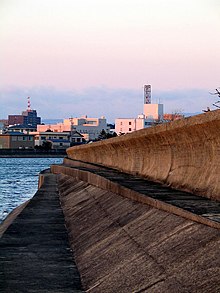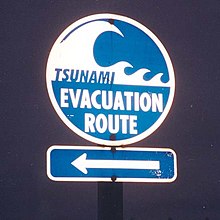MEGATSUNAMIS
What is Megatsunami? Megatsunami (also known as
iminami or "purification wave")
[1] is an informal term to describe a
tsunami that has initial
wave heights that are much larger than normal tsunamis. Unlike usual tsunamis, which originate from
tectonic activity and the raising or lowering of the
sea floor, known megatsunamis have originated from large scale
landslides or
impact events.
Concept
A megatsunami is meant to refer to a tsunami with an initial
wave amplitude (
height) measured in several tens, hundreds, or possibly thousands of meters.
Normal tsunamis generated at sea result from movement of the sea floor. They have a small wave height offshore, and a very long
wavelength (often hundreds of kilometers long), and generally pass unnoticed at sea, forming only a slight swell usually of the order of 30 cm (12 in) above the normal sea surface. When they reach land the wave height increases dramatically as the base of the wave pushes the water column above it upwards.
By contrast, megatsunamis are caused by giant landslides and other
impact events. Underwater
earthquakes or
volcanic eruptions do not normally generate such large tsunamis, but
landslides next to bodies of water resulting from earthquakes can, since they cause a massive amount of
displacement. If the landslide or impact occurs in a limited body of water, as happened at the
Vajont Dam (1963) and
Lituya Bay (1958) then the water may be unable to disperse and one or more exceedingly large waves may result.
Two heights are sometimes quoted for megatsunamis - the height of the wave itself (in water), and the height to which it washes when it reaches land, which depending upon the locale, can be several times larger.
History of the hypothesis
Geologists searching for oil in
Alaska in 1953 observed that in
Lituya Bay, mature tree growth did not extend to the shoreline as it did in many other bays in the region. Rather, there was a band of younger trees closer to the shore. Forestry workers, glaciologists, and geographers call the boundary between these bands a
trim line. Trees just above the trim line showed severe scarring on their seaward side, whilst those from below the trim line did not. The scientists hypothesized that there had been an unusually large wave or waves in the deep inlet. Because this is a recently deglaciated
fjord with steep slopes and crossed by a major fault, one possibility was a landslide-generated tsunami.
[2]On 9 July 1958, an earthquake of magnitude 7.7 (on the
Richter scale), caused 90 million tonnes of rock and ice to drop into the deep water at the head of Lituya Bay. The block fell almost vertically and hit the water with sufficient force to create a
wave approximately 524 metres (1,719 ft) high. Howard Ulrich and his son, Howard Jr., were in the bay in their fishing boat when they saw the wave. They both survived and reported that the wave carried their boat "over the trees" on one of the initial waves which washed them back into the bay, though the larger wave did not harm them a great lot. A similar tsunami out at sea could come tens of kilometers inland.
This event and evidence of a potentially similar past event at the same location inspired the term
megatsunami.
List of Megatsunami
Prehistoric
1-The
asteroid which created the
Chicxulub crater in
Yucatan approximately 65 million years
BP would have generated some of the largest megatsunami in Earth's history.
2-A series of megatsunami were generated by the
bolide impact that created the
Chesapeake Bay impact crater, about 35.5 million years
BP.
[3]
3-At
Seton Portage, British Columbia, Canada, a freshwater megatsunami may have occurred approximately 10,000 BP.
[4] A huge block of the
Cayoosh Range suddenly slid northwards into what had been a large lake spanning the area from
Lillooet, British Columbia to near Birken, in the Gates Valley or Pemberton Pass to the southwest. The event has not been studied in detail, but the proto-lake (freshwater
fjord) may have been at least as deep as the two present-day halves,
Seton and
Anderson Lakes, on either side of the
Portage, suggesting that the surge generated by the giant
landslide in the narrow mountain confines of the fjord valley may have been comparable in scale to
Lituya Bay. Another more recent landslide on the south shore of Anderson Lake dropped a large portion of high mountainside down a debris chute, creating a rockwall "fan" which
must have made a megatsunami-type wave, though not as large as the main one at the Portage.
4-Approximately 8,000 BP, a massive volcanic landslide off of
Mt. Etna,
Sicily caused a megatsunami which devastated the eastern
Mediterranean coastline on three continents.
[5]
6-Approximately 6000 years ago, a landslide on
Réunion island, to the east of
Madagascar, may have caused a megatsunami.
[7]
7-The recently discovered undersea
Burckle Crater located at the bottom of the
Indian Ocean would have caused a megatsunami at the time of impact estimated to be c. 3000–2800 BCE. It is unknown whether the Burckle Crater is connected to the
Fenambosy Chevron which provides evidence of another megatsunami.
8-Evidence for large landslides has been found in the form of extensive underwater debris aprons around many volcanic ocean islands which are composed of the material which has slid into the ocean. The island of
Molokai had a catastrophic collapse over a million years ago; this underwater landslide likely caused large tsunamis. In recent years, five such debris aprons have been located around the
Hawaiian Islands. The
Canary Islands have at least 14 such debris aprons associated with the
archipelago.
Modern
1792: Mount Unzen, Japan
Main article:
Mount UnzenIn 1792,
Mount Unzen in
Japan erupted, causing part of the
volcano to collapse into the sea. The landslide caused a megatsunami that reached 100 meters (328 ft) high and killed 15,000 people in the local fishing villages.
1958: Lituya Bay, Alaska, USA
On 9 July 1958, a giant landslide at the head of
Lituya Bay in Alaska, caused by an earthquake, generated a wave with an initial amplitude of 524 meters (1,719 ft). This is the highest wave ever recorded, and surged over the headland opposite, stripping trees and soil down to bedrock, and surged along the
fjord which forms Lituya Bay, destroying a fishing boat anchored there and killing two people. Howard Ulrich and his son managed to ride the wave in their boat, and both survived.
1963: Vajont Dam, Italy
1980: Spirit Lake, Washington, USA
On May 18, 1980, the upper 460 meters of
Mount St. Helens failed and detached in a massive
landslide. This released the pressure on the magma trapped beneath the summit bulge which exploded as a
lateral blast, which then released the over-pressure on the magma chamber and resulted in a
plinian eruption. One lobe of the avalanche surged onto
Spirit Lake, causing a megatsunami which pushed the lake waters in a series of surges, which reached a maximum height of 260 metres
[8] above the pre-eruption water level (~975 m asl). Above the upper limit of the tsunami, trees lie where they were knocked down by the
pyroclastic surge; below the limit, the fallen trees and the surge deposits were removed by the megatsunami and deposited in Spirit Lake.
[9]Potential Future Megatsunami
Experts interviewed by the BBC think that a massive landslide on a volcanic ocean island is the most likely future cause of a megatsunami.
[10] The size and power of a wave generated by such means could produce devastating effects, travelling across oceans and inundating up to 25 kilometres (16 mi) inland from the coast.
British Columbia
Canary Islands
Geologists S. Day and S. Ward consider that a megatsunami could be generated during a future eruption involving the
Cumbre Vieja on the volcanic ocean island of
La Palma, in the
Canary Islands.
[12][13] In 1949, the Cumbre Vieja volcano erupted at its
Duraznero,
Hoyo Negro and
San Juan vents. During this eruption, an earthquake with an epicentre near the village of
Jedy occurred. The following day
Rubio Bonelli, a local geologist, visited the summit area and discovered that a fissure about 2.5 kilometers (2 mi) long had opened on the eastern side of the summit. As a result, the western half of the Cumbre Vieja (which is the volcanically active arm of a triple-armed rift) had slipped about 2 meters (7 ft) downwards and 1 meters (3 ft) westwards towards the
Atlantic Ocean.
The Cumbre Vieja volcano is currently in a dormant stage, but will almost certainly erupt again in the future. Day and Ward hypothesize
[12][13] that if such an eruption causes the western flank to fail, a megatsunami will be generated.
La Palma is currently the most volcanically active island in the
Canary Islands Archipelago. It is likely that several eruptions would be required before failure would occur on Cumbre Vieja.
[12][13] However, the western half of the volcano has an approximate volume of 500 cubic kilometres (120 cu mi) and an estimated mass of 1,500,000,000,000 metric tons (1.7
×1012 short tons) If it were to catastrophically slide into the ocean, it could generate a wave with an initial height of about 1,000 metres (3,300 ft) at the island, and a likely height of around 50 metres (164 ft) at the
Caribbean and the Eastern
North American seaboard when it runs ashore eight or more hours later. Tens of millions of lives would be lost as New York, Boston, Baltimore, Washington, D.C., Miami, Havana, and many other cities near the Atlantic coast are leveled. The likelihood of this happening is a matter of vigorous debate.
[14]
The last Cumbre Vieja eruption occurred in 1971 at the southern end of the sub-aerial section without any movement. The section affected by the 1949 eruption is currently stationary and does not appear to have moved since the initial rupture.
[15]
Geologists and
volcanologists also disagree about whether an eruption on the Cumbre Vieja would cause a single large gravitational landslide or a series of smaller landslides.
Hawaii
Prehistoric sedimentary deposits on the
Kohala Volcano,
Lanai and
Molokai controversially indicates that landslides from the flank of the
Kilauea and
Mauna Loa volcanoes in
Hawaii may have triggered past megatsunamis, most recently at 120,000
BP.
[16][17][18] A future tsunami event is also possible, with the tsunami potentially reaching up to about 1 kilometre (3,300 ft) in height.
[19][20] According to a documentary called National Geographic's Ultimate Disaster: Tsunami, if a big landslide occurred at Mauna Loa, a 30 metres (98 ft) tsunami would take only thirty minutes to reach
Honolulu, Hawaii. There, hundreds of thousands of people would be killed as the tsunami leveled Honolulu and traveled 25 kilometres (16 mi) inland.
 Whatever name they call it, the Tsunami had left a very big impact to the affected areas in Asian region which changed the lives of the survivors and the landscape forever.
Whatever name they call it, the Tsunami had left a very big impact to the affected areas in Asian region which changed the lives of the survivors and the landscape forever.  According to the U.S. Geological Survey a total of 227,898 people died. Measured in lives lost, this is one of the ten worst earthquakes in recorded history, as well as the single worst tsunami in history. Indonesia was the worst affected area, with most death toll estimates at around 170,000. However, another report by health minister of Indonesia, Fadilah Supari has estimated the death total to be as high as 220,000 in Indonesia alone, giving a total of 280,000 casualties.
According to the U.S. Geological Survey a total of 227,898 people died. Measured in lives lost, this is one of the ten worst earthquakes in recorded history, as well as the single worst tsunami in history. Indonesia was the worst affected area, with most death toll estimates at around 170,000. However, another report by health minister of Indonesia, Fadilah Supari has estimated the death total to be as high as 220,000 in Indonesia alone, giving a total of 280,000 casualties.






















